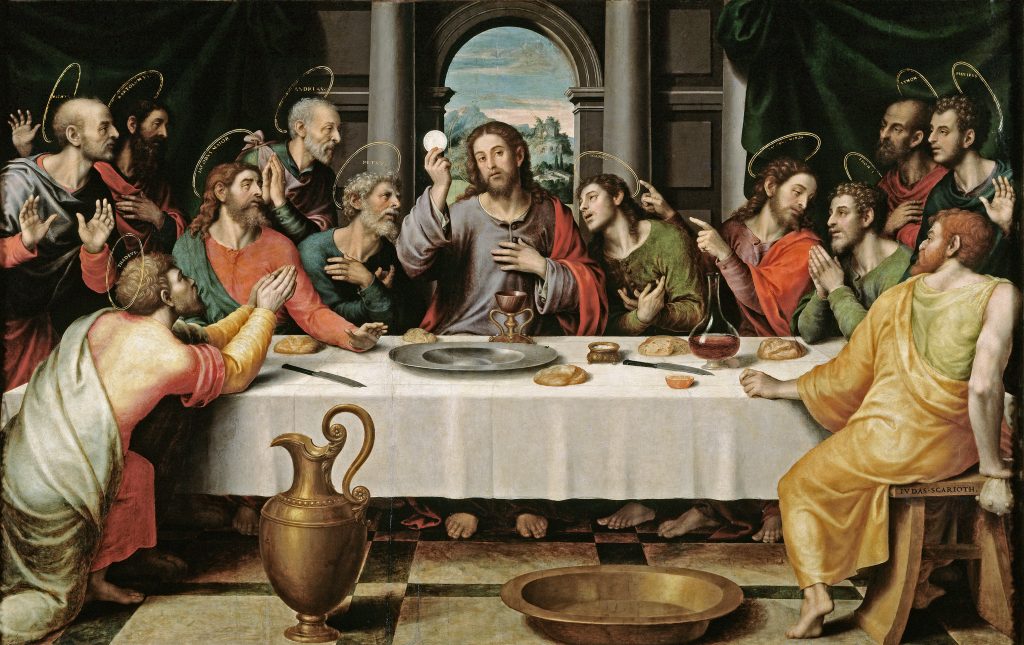
Lesson Objectives
- To read Genesis 1-12 with understanding.
- To learn the meaning of the first two covenants of salvation history - the Sabbath, and the covenant made with Noah.
- To begin to understand the "patterns" of biblical history.
IV. A New Creation, A New Covenant
A. Falling Towards a Flood
The chapters that follow in Genesis (see Genesis 3-5) show us "the fall" of our first human ancestors - from divinely made son and daughter living in paradise, to wayward children who reject their Father's wisdom and squander their birthright, losing their home.
The Devil, in the form of the serpent, tempts them and leads them astray (see Catechism, nos. 391-395). And sin - the rejection of God's Fatherhood - enters the generations of humankind.
But even as His children have exiled themselves from paradise through sin, God promises them redemption, a homecoming.
He promises that throughout human history there will be an "enmity" between the serpent, Satan, and the woman, "the mother of all the living," and between their offspring (seeGenesis 3:15, 20).
There begins the tension that will shape the rest of Genesis and the rest of the Bible - between the bad seed of sin and the seed of righteousness.
The first child born of original sin, Cain, becomes the world's first murder. As Adam and Eve, the first children of God, rejected the Fatherhood of God, their children reject the brotherhood of man, symbolized in Cain's spiteful words to God: "Am I my brother's keeper?" (see Genesis 4:9).
But there is also a good seed born of Adam and Eve - Seth. It's the children of Seth, born of Seth's son, Enosh, who first begin to worship God, to "invoke the Lord by name" (seeGenesis 4:26). The word name in Hebrew is shem. Just remember that for now, it will become important later.
Violence and lawlessness and immorality began to fan out on the face of the earth until finally it infects the "sons of heaven," that is the children of Seth (see Genesis 6:1-4). What happens in Genesis 6 is that Seth's descendants, seduced by the beauty of the daughters of Cain, take them as wives. Worse yet, they took more than one wife - "as many of them as they chose." The sons of Seth violate the sanctity of the marriage covenant instituted by God in the garden.
The fruits of the "intercourse" of the sons of Seth and the daughters of Cain were men of even more violence and wickedness - "men of renown," which Scripture elsewhere calls "proud giants...skilled in war" (see Wisdom 14:6; Baruch 3:26-27).
Finally, God is overcome with "sorrow" and "regret" at "how corrupt the earth had become, since all mortals led depraved lives" (see Genesis 6:5,7,12).
B. Beginning With the Rain
The stage has been set for God's second covenant with His creation - the covenant made with Noah.
In bringing the flood, God is depicted as wanting to restart the whole world. The account is filled with echoes of the Genesis creation story:
The new world wells up from the chaotic waters of "the abyss" (compare Genesis 1:2 and7:11).
You'll also notice a lot of "sevens" in the story of Noah: pairs of clean animals (see Genesis 7:2); seven days before the flood was brought on (7:10); on the seventh month the ark came to "rest" on Mount Ararat (8:4). Noah sends out a dove every seven days until one brings back the olive tree branch (8:10-12)
Noah is described as a new "first man." Like Adam, Noah is given authority over the animals (9:2). He is also given the same command as God gave to Adam: "be fertile and multiply and fill the earth." (9:1). Finally, as He did with Adam, God makes a covenant with Noah and through him with all living beings (9:13).
With this covenant, God renews His covenant with creation. By this covenant, God also expands the "family structure" of His covenant people - from a husband and a wife to a family unit. Noah's family - his wife and three sons and their wives - is included in the blessings of this covenant.
C. The Story of Two Names
The Scripture also depicts Noah, like Adam, falling from grace.
Here, too, we hear echoes of the story of Adam in the story of Noah.
As Adam (whose name in Hebrew is almost identical to the word for "ground," adama , allowing for a wordplay between the two) was given a garden to till, Noah plants a vineyard and becomes "a man of the soil" (see Genesis 2:15; 9:20). And as the forbidden fruit of the garden proves to be Adam's downfall, so the fruit of Noah's vine, wine, becomes his. And like Adam's fall, Noah's exposes his sin and nakedness (see Genesis 3:6-7; 9:21) and results in a curse (see Genesis 3:14-19; 9:25).
What does it mean that Ham, one of Noah's three sons, "saw his father's nakedness"?
In Hebrew, this phrase is actually an idiom, a figure of speech, that describes incest. (Leviticus 20:17; 18:6-18. Note: The New American Bible translates the phrase "to have intercourse with" while the Revised Standard Version keeps the more literal translation "uncover the nakedness of" RSV-Leviticus 20:17; 18:6-18).
To uncover the nakedness of your father is to commit incest with your mother.
To put it bluntly - while Noah was drunk, Ham slept with his mother. We can only speculate as to Ham's motives. It's reasonable, based on other evidence in the Scripture, to presume that Ham wanted to seize his father's authority. Sleeping with his mother was the ultimate insult and sign of disrespect (see similar episodes in Genesis 35:22; 49:3-4; 2 Samuel 16:21-22).
The son born of this incestuous encounter is Canaan. He will grow up to be the father of a nation known and reviled for its abominable practices (see Leviticus 18:6-18; Exodus 23:23-24).
But as Adam bore both Cain, the slayer of his brother, and Seth the righteous one, Noah too has a good seed: his firstborn son Shem, who had tried to "cover" his father's nakedness (see Genesis 9:23).
Genesis 10 gives us the origins of nations and the genealogy of conflict between the two seeds of Noah. The descendants of Ham become the great national enemies of the people of God - Egypt, Canaan, Philistia, Assyria and Babylon. The great patriarch Abraham, who we'll read about in the next lesson, is descended from the line of Shem.
From this line, came the nations who tried to build the Tower of Babel in order "to make a name [Hebrew = shem] for themselves" (Genesis 11:1-9). In other words, they were trying to build a kind of "counter-kingdom" to stand against the name of God.
God defeats them - scatters them in a confusion of languages.
Remember what we said above: Shem is the Hebrew word for "name." And from the line of Shem, God raises up His chosen people.
The Jews are "Shemites" which is where we get our modern expression "anti-Semitic" or "anti-Semite." The Jews descend from Shem's great grandson Abram (see Genesis 11:10-26), to whom God promises: "I will bless you. I will make your name [Hebrew = shem] great."
We'll pick up with Father Abraham in our next class.
Other Lessons
- Lesson One: The Master Key that Unlocks the Bible
- To learn the "big-picture" overview of the Bible - the story that the Bible tells.
- To understand the concept of "covenant" and its importance for reading and interpreting the Bible.
- To learn in general detail the six major covenants in the Bible.
- Lesson Three: Our Father, Abraham
- To read Genesis 12-50 with understanding.
- To understand God’s covenant with Abraham and to see how that covenant is fulfilled in the New Covenant of Jesus Christ.
- To appreciate key figures and elements in the Abraham story - Melchizedek, circumcision, the sacrifice of Isaac - as they are interpreted in the Church’s tradition.
- Lesson Four: The First-Born Son of God
- To read the Books of Exodus, Leviticus, Numbers, and Deuteronomy with understanding.
- To understand God’s covenant with Israel at Sinai and to see how this covenant looks forward to and is fulfilled in the New Covenant of Jesus Christ.
- To appreciate the key figures and events - Moses, the Passover, and the vocation of Israel as “a kingdom of priests” - as they are interpreted in the Church’s tradition.
- Lesson Five: A Throne For All Generations
- To finish reading the Old Testament (from Joshua to Malachi) and to read with understanding.
- To understand the broad outlines of the history of Israel in light of God’s covenant with Abraham.
- To appreciate the crucial importance of God’s everlasting covenant with David.
- Lesson Six: The New and Everlasting Covenant
- To read the New Testament with understanding.
- To understand how the New Testament depicts Jesus as the fulfillment of the covenants of the Old Testament.
- To appreciate, especially, the importance of God’s everlasting covenant with David for understanding the mission of Jesus and the Church as it is presented in the New Testament.

